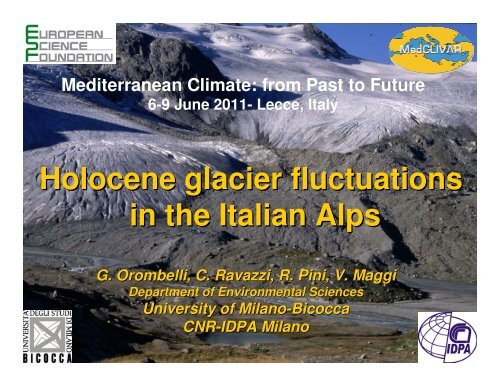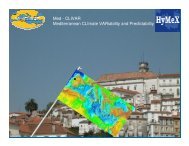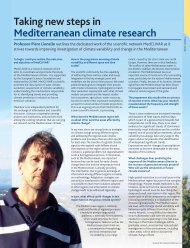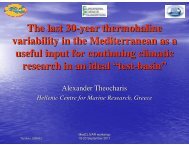Holocene glacier fluctuations in the Italian Alps - Medclivar
Holocene glacier fluctuations in the Italian Alps - Medclivar
Holocene glacier fluctuations in the Italian Alps - Medclivar
- No tags were found...
Create successful ePaper yourself
Turn your PDF publications into a flip-book with our unique Google optimized e-Paper software.
Mediterranean Climate: from Past to Future6-9 June 2011- Lecce, Italy<strong>Holocene</strong> <strong>glacier</strong> <strong>fluctuations</strong><strong>in</strong> <strong>the</strong> <strong>Italian</strong> <strong>Alps</strong>G. Orombelli, C. Ravazzi, , R. P<strong>in</strong>i, V. MaggiDepartment of Environmental SciencesUniversity of Milano-BicoccaCNR-IDPA Milano
Some thousand <strong>glacier</strong>s are present <strong>in</strong> Italy, from<strong>the</strong> Maritime to <strong>the</strong> Julian <strong>Alps</strong>, with a s<strong>in</strong>gle small<strong>glacier</strong> <strong>in</strong> <strong>the</strong> Apenn<strong>in</strong>es.Can<strong>in</strong> gl.Julian <strong>Alps</strong>Clapier gl.Maritime <strong>Alps</strong>Calderone gl.Comitato Glaciologico <strong>Italian</strong>o http://www.glaciologia.it/
Mounta<strong>in</strong> <strong>glacier</strong>s, ma<strong>in</strong>ly composed by ice at <strong>the</strong> melt<strong>in</strong>g temperature,are particularly sensitive to climate changes, respond<strong>in</strong>g with variations<strong>in</strong> length and volume. S<strong>in</strong>ce late 19th century, <strong>glacier</strong> frontal <strong>fluctuations</strong>have been considered as proxy of climate changes. . The spectacularretreat of mounta<strong>in</strong> <strong>glacier</strong>s <strong>in</strong> <strong>the</strong> last three decades is considered as<strong>the</strong> most clear and conv<strong>in</strong>c<strong>in</strong>g evidence of global warm<strong>in</strong>g.1985Recession of Morteratsch Glacier (CH) between 1985 and 20072007Source: : J. Alean, SwissEduc (www.swisseduc.chwww.swisseduc.ch) / Glaciers onl<strong>in</strong>e (www.<strong>glacier</strong>swww.<strong>glacier</strong>s-onl<strong>in</strong>e.netonl<strong>in</strong>e.net).
<strong>Holocene</strong> <strong>glacier</strong> <strong>fluctuations</strong>.Historic, stratigraphic and geomorphicevidence, produc<strong>in</strong>g a discont<strong>in</strong>uousrecord of <strong>glacier</strong> advance phases.Evidence of retreat phases was largelydestroyed by sub-sequentsequent advances.
Subdivisions of <strong>the</strong> <strong>Holocene</strong>On <strong>the</strong> base of most recent studies, <strong>the</strong> <strong>Holocene</strong>history of mounta<strong>in</strong> <strong>glacier</strong>s <strong>in</strong> <strong>the</strong> Nor<strong>the</strong>rn hemi-sphere can be broadly subdived <strong>in</strong> three ma<strong>in</strong>periods:- a first period (11.7 to ~ 10.2 kyr BP)correspond<strong>in</strong>g to <strong>the</strong> Preboreal chronozone- a second period ( ~ 10.2 ÷ 5 kyr BP)correspond<strong>in</strong>g ~ to <strong>the</strong> Boreal and Atlanticchronozones (<strong>in</strong>formally<strong>in</strong>dicated as Hypsi<strong>the</strong>rmal)- a third period (<strong>the</strong> last ~ 5 000 years)correspond<strong>in</strong>g to Subboreal-SubatlanticSubatlantic chronoz.often named Neoglaciation or Neoglacial
The first period (11.7(11.7 to ~ 10.2 kyr BP)Fluctuations of mounta<strong>in</strong> <strong>glacier</strong>s dur<strong>in</strong>g <strong>the</strong>first period (Early<strong>Holocene</strong>) ) are poorly known.Glacier advances have been reported <strong>in</strong> manymounta<strong>in</strong> cha<strong>in</strong>s of <strong>the</strong> world (Scand<strong>in</strong>avia, Canada,Andes, , Patagonia).In <strong>the</strong> Swiss <strong>Alps</strong> <strong>the</strong> youngest mora<strong>in</strong>es of <strong>the</strong> LateGlacial Egesen Stade (Egesen2, 3 & Kartell advances)are <strong>in</strong> fact Early <strong>Holocene</strong>/Preboreal<strong>in</strong> age(Ivy-Ochset al., 2009).<strong>Holocene</strong>11.7Egesen StadePleistocene
10 Be weighted mean age: : 11 340 ± 370 yr12 110 ± 52011 880 ± 70011 340 ± 49010 460 ± 470In <strong>the</strong> <strong>Italian</strong> <strong>Alps</strong> mora<strong>in</strong>es were recently datedby exposure ages to <strong>the</strong> latest Pleistocene - Early<strong>Holocene</strong> at Pian del Praiet (Maritime<strong>Alps</strong>)(Federiciet al., 2008)
Be exposure ages for Egesen andEarly <strong>Holocene</strong> mora<strong>in</strong>es(and rock <strong>glacier</strong>s) ) <strong>in</strong> <strong>the</strong> <strong>Alps</strong>10 Be(A)TyrolAustriaEngad<strong>in</strong>CHValtell<strong>in</strong>aItalyBernese<strong>Alps</strong>CHMaritime Tyrol<strong>Alps</strong> AustriaItalyTyrolAustriaIvy-Ochs et al., 2009
NLa MareGlacierMax LIA <strong>glacier</strong>extentPeatbog at 2270 mbasal peat age:10 390 - 10 090 cal. BP0.5 kmS<strong>in</strong>ce ~ 10.2 kyr BP <strong>Italian</strong> <strong>glacier</strong>s were reduced to <strong>the</strong>irpresent size. Basal peat just out of LIA mora<strong>in</strong>es ofLa Mare Glacier (Central <strong>Alps</strong>) dates to 10.4-10.110.1 kyr BP, sug-gest<strong>in</strong>g a <strong>glacier</strong> extent comparable to <strong>the</strong> present one.
Ruitor gl.was smallerthan now10.3-1010 Kyr BPBuried peat bognear <strong>the</strong> <strong>glacier</strong>front*2510 m a.s.l.*Basalpeat10 270 – 9 950cal yr BPmax Little Ice Age<strong>glacier</strong> extent(1820 ?)N1 km2003
The second period (10.2 ÷ 5 kyr BP)was characterized by a generally reduced<strong>glacier</strong> activity.In many mounta<strong>in</strong> cha<strong>in</strong>s (Nor<strong>the</strong>rnH.)<strong>glacier</strong>s where <strong>in</strong> a prevail<strong>in</strong>g retreatedcondition and locally <strong>the</strong>y entirelydisappeared.In <strong>the</strong> <strong>Italian</strong> <strong>Alps</strong> a representative sectionis present near <strong>the</strong> front of <strong>the</strong> Ruitor Glacier(Western <strong>Alps</strong>),where a peat bog buried byglacigenic sediments has been found at2510 m a.s.l.
Compressed anddeformed peattillRuitor Glaciermid 80s mora<strong>in</strong>e
9 070 ±120÷ 4 945 ±6514 C yr BP~ 10 000 ÷ 5 600 cal yr BPOrombelli, , 1998The Ruitor section:calibrated 14 C ages ofcont<strong>in</strong>uous peat sediments(~10–6.7 kyr BP)and of peat clasts(6.7-5.6 kyr BP).Conditions favourable topeat formation prevailedfrom ~10 to 5.6 kyr BP.
The third period: : <strong>the</strong> last 5000 yearsThis period is often referred to as Neoglaciation(Porter & Denton 1967) s<strong>in</strong>ce it was characterized bya general reactivation/reappearancereappearance of mounta<strong>in</strong><strong>glacier</strong>s.Several phases of advance (and retreat)punctuated this period, culm<strong>in</strong>at<strong>in</strong>g around 5000,3800, 3100, 2500, 1400, 900, 650, 350 and 150years b2k(Wanneret al. 2008)In <strong>the</strong> <strong>Italian</strong> <strong>Alps</strong> <strong>the</strong>re is evidence of <strong>the</strong> start of<strong>the</strong> Neoglaciation at <strong>the</strong> Miage and Niederjoch<strong>glacier</strong>s at about 5 000 ys BP.
Miagelateral mora<strong>in</strong>eCombal outwash pla<strong>in</strong>Miage mora<strong>in</strong>icamphi<strong>the</strong>tre1332-1172 BP5029-4575 BPThe “Lake” Combal pla<strong>in</strong> dammed by <strong>the</strong> right lateral mora<strong>in</strong>eof <strong>the</strong> Miage Gl. . (Mont BLanc) ) and by <strong>the</strong> small Miageamphiteatre. . The lake was first formed by an advance block<strong>in</strong>g<strong>the</strong> valley before ~ 4.8 kyr BP (Del<strong>in</strong>e& Orombelli, 2005) .
Niederjoch/Giogo Basso Gl.(Baroni & Orombelli, 1995)Ötzi(~ 5200 cal BP)The mummified corpse of <strong>the</strong>iceman rested directly on bedrock,suggest<strong>in</strong>g that, after death, itbecame buried <strong>in</strong> snow on ice-freeground ~ 5.2 kyr BP and s<strong>in</strong>ce <strong>the</strong>nrema<strong>in</strong>ed cont<strong>in</strong>uously preserved<strong>in</strong> cold ice, frozen to bedrock at <strong>the</strong>upper edge of <strong>the</strong> Giogo Basso Gl.(Eastern<strong>Alps</strong>).At about 5.2 kyr BP, for an abrupt climate change, GiogoBasso <strong>glacier</strong> started to re-form near <strong>the</strong> Tisa Pass <strong>in</strong> itsupper accumulation bas<strong>in</strong>.
advanc<strong>in</strong>gre-form<strong>in</strong>gCalderone <strong>glacier</strong>absentIn <strong>the</strong> Apenn<strong>in</strong>es <strong>the</strong> CalderoneGlacier, possibly still presentdur<strong>in</strong>g <strong>the</strong> Late Glacial, disappea-red <strong>in</strong> <strong>the</strong> Early <strong>Holocene</strong>, , andre-formedat 4.5-4.34.3 kyr BP(Giraudiet al., 2011)possiblypresent
Two Mid-Neoglacialadvance phases are recorded <strong>in</strong> <strong>the</strong><strong>Italian</strong> <strong>Alps</strong> at 3 - 2.5 kyr Bp and <strong>in</strong> <strong>the</strong> early Middle AgesVII – IX centuries ADForni Glacier (Ortles(Ortles-Cevedale Group),reached a frontalposition a few metresdownvalley of <strong>the</strong>sub-sequentsequent max.LIA mora<strong>in</strong>e, around3 - 2.7 kyr BPMid-Neoglacialadvance3 - 2.7 kys BPMax LIA ~ 1859
The Little Ice Age <strong>in</strong> <strong>the</strong> <strong>Italian</strong> <strong>Alps</strong>The Little Ice Age (LIA) mora<strong>in</strong>es are ubiquitous andwell preserved at <strong>the</strong> forefield of <strong>the</strong> <strong>Italian</strong> <strong>glacier</strong>s,where <strong>the</strong>y generally represent <strong>the</strong>ir <strong>Holocene</strong> max.advance. They date ma<strong>in</strong>ly to <strong>the</strong> last major phaseof advance <strong>in</strong> <strong>the</strong> XIX century.TrioletPré de BarLittle Ice Age mora<strong>in</strong>es
(d’Osterwald 1826)Triolet and Pré de Bar <strong>glacier</strong>s <strong>in</strong> 1820
The Little Ice Age <strong>in</strong> <strong>the</strong> <strong>Alps</strong>Three ma<strong>in</strong> advance phasesoccurred <strong>in</strong> <strong>the</strong> <strong>Alps</strong> dur<strong>in</strong>g<strong>the</strong> Little Ice Age, as shown by<strong>the</strong> Great Aletsch <strong>glacier</strong>:1360-139013901600-165016501820-6034502005Holzhauser, Magny & Zumbuhl, , 2005
Earlier phases of <strong>the</strong> LIA <strong>in</strong> <strong>the</strong> <strong>Italian</strong> <strong>Alps</strong> are recorded byhistoric documents of <strong>the</strong> Ruitor floods. When <strong>in</strong> an advancedposition, <strong>the</strong> Ruitor Glacier dammed a lake, which producedrepeated outburst floods, damag<strong>in</strong>g La Thuile & Aosta valleys.Ruitor delta-mora<strong>in</strong>e(Favre,, 1864)The ice-dammedlake of Ruitor (La Thuile)<strong>in</strong> 1862Ruitor glacial ouburst floods:1284 ?1371 ÷ 1470 ?1594, 1595, 1596,1597,15981630, 1640, 1646, 1679, 168017511864LIA maxextentRuitor LakeRuitorGl.
The Little Ice Age <strong>in</strong> <strong>the</strong> <strong>Italian</strong> <strong>Alps</strong>A few mora<strong>in</strong>es/advanceadvance phases have been dated to<strong>the</strong> first decades of <strong>the</strong> XVII century ( Miage, Lys,VerraVerra),but <strong>the</strong> best documented part of <strong>the</strong> LIA is <strong>in</strong> <strong>the</strong> first halfof <strong>the</strong> XIX century.In <strong>the</strong> Western <strong>Alps</strong> many <strong>glacier</strong>s reached <strong>the</strong>ir maximumextent <strong>in</strong> 1818-18201820. After a retreat <strong>in</strong> <strong>the</strong> 1830s a secondlargest advance occurred <strong>in</strong> 1845-18601860.In <strong>the</strong> Central <strong>Alps</strong> <strong>the</strong> Forni <strong>glacier</strong> reached its maximumsize <strong>in</strong> 1859.S<strong>in</strong>ce <strong>the</strong> second half of <strong>the</strong> XIX century <strong>the</strong> <strong>Italian</strong> <strong>glacier</strong>swere retreat<strong>in</strong>g, with only m<strong>in</strong>or re-advancephases around1890-9595, 1920-2525 and 1965–19851985, reach<strong>in</strong>g more and moreretreated positions.
The retreat of Forni Glacier, Valtell<strong>in</strong>a,<strong>in</strong> <strong>the</strong> last centuryPhoto Folladori~ 18901998
<strong>Holocene</strong> <strong>fluctuations</strong> of <strong>Italian</strong> <strong>glacier</strong>s compared toadvance/retreatphases on <strong>the</strong> Nor<strong>the</strong>rn side of <strong>the</strong> <strong>Alps</strong>BrenvaLysCalderoneForniLysCalderoneCalderoneMiage“Iceman”LIAGöschener 2Göschener 1Ruitor peat“Neoglacial Neoglacial”LateMidEarly5Val ViolaMaritime <strong>Alps</strong>~10.211.7<strong>glacier</strong> friendly<strong>glacier</strong> hostileclimatic conditionsconditions Ivy-Ochs et al. 2009
Val Savaranche (Gran Paradiso)remnants of <strong>glacier</strong>s nested <strong>in</strong>side 19 th century mora<strong>in</strong>esThe <strong>Italian</strong> <strong>glacier</strong>s <strong>in</strong> <strong>the</strong> AnthropoceneThank you for your attentionCNR IRPI – Tor<strong>in</strong>o - 2000






